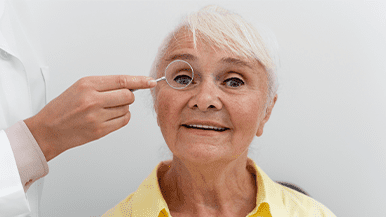Imagine slowly losing your visual clarity, having what was once sharp replaced by a cloudiness you can’t get rid of no matter the strength of your glasses or contacts. For Janice, a patient of Ocala Eye, this became her reality as cataracts began to affect her daily living.
Janice could no longer read or drive, and she wound up feeling distant and disconnected from those around her – until she underwent treatment for cataracts at Ocala Eye using the accommodating lens technology. “It’s been an immense difference in the quality of my life,” Janice says. “I can see anything. I don’t have to wear glasses to read or to drive anymore.”
What is a Cataract?
A cataract is characterized as a clouding of the lens in the eye that affects vision. The lens is the clear part of the eye that helps to focus light and images on the retina, which is the light-sensitive tissue located at the back of the eye. In an eye functioning normally, light passes through the transparent lens to the retina. After reaching the retina, light is converted to nerve signals that are sent to the brain. If the lens is cloudy from a cataract, the image seen will be blurred or cloudy, hazy and less colorful.
More than 24.4 million Americans have cataracts, and the condition primarily affects older individuals. By age 80, more than 50% of all people in the US either have a cataract or have had laser vision cataract surgery.
The most common type of cataract is related to the normal aging process of the eye. It is possible to develop an age-related cataract as young as 40.
 Signs and symptoms of cataracts include:
Signs and symptoms of cataracts include:
- Cloudy, dim or blurred vision
- Progressively greater difficulty seeing things at night
- Sensitivity to light and glare
- Needing bright lights while reading or other activities
- Seeing “halos” around lights
- Having to change eyeglass or contact lens prescriptions often
- Fading or yellowing of colors
- Having double vision in just one eye
Beyond aging, there are factors that can affect a person’s likelihood of developing a cataract including diabetes, excessive exposure to sunlight, smoking, high blood pressure and previous eye injury, surgery or inflammation.
There are a few different types of cataracts that are differentiated according to which part of the lens is affected.
Treatment for Cataracts
The only way to get rid of a cataract is with surgery, but generally, the surgery is reserved for patients whose blurry vision interferes with their normal everyday activities, like Janice.
Cataract surgery is generally performed as an outpatient procedure. In most modern cataract procedures, the opthalmologist uses a high-frequency ultrasound device that breaks up the cloudy lens into small pieces that are then gently removed using suction. Another option is laser-assisted cataract surgery, which involves creating corneal incisions, removing the anterior capsule of the lens, and fragmenting the cataract. Although this method reduces the need for surgical blades and other hand-held tools, this surgery is generally less popular due to the high cost.
Janice opted for an accommodating lens surgery, which helped to correct several vision problems she was experiencing.
“The accommodating lens improves not only your distance vision but also corrects your reading vision…and then, of course, it improves the cloudiness,” Janice explains.
“My advice is if you have to have to have the cataract surgery, I would really recommend the accommodating lens if you’re having trouble with reading,” says Janice. “I am now able to read without glasses, and I couldn’t be happier.”




